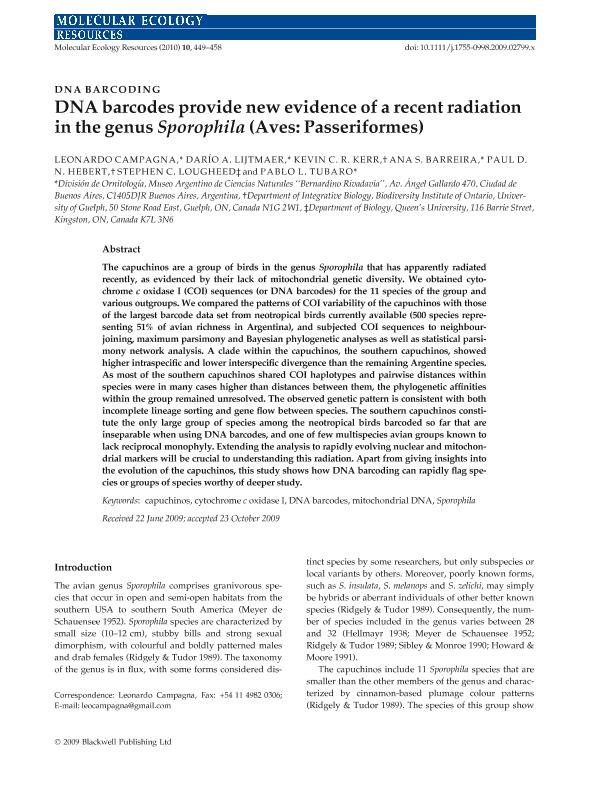Mostrar el registro sencillo del ítem
dc.contributor.author
Campagna, Leonardo

dc.contributor.author
Lijtmaer, Dario Alejandro

dc.contributor.author
Kerr, Kevin C. R.
dc.contributor.author
Barreira, Ana Soledad

dc.contributor.author
Hebert, Paul David Neil

dc.contributor.author
Lougheed, Stephen C.
dc.contributor.author
Tubaro, Pablo Luis

dc.date.available
2019-01-31T16:48:47Z
dc.date.issued
2010-05
dc.identifier.citation
Campagna, Leonardo; Lijtmaer, Dario Alejandro; Kerr, Kevin C. R.; Barreira, Ana Soledad; Hebert, Paul David Neil; et al.; DNA barcodes provide new evidence of a recent radiation in the genus Sporophila (Aves: Passeriformes); Wiley Blackwell Publishing, Inc; Molecular Ecology Resources; 10; 3; 5-2010; 449-458
dc.identifier.issn
1755-098X
dc.identifier.uri
http://hdl.handle.net/11336/69111
dc.description.abstract
The capuchinos are a group of birds in the genus Sporophila that has apparently radiated recently, as evidenced by their lack of mitochondrial genetic diversity. We obtained cytochrome c oxidase I (COI) sequences (or DNA barcodes) for the 11 species of the group and various outgroups. We compared the patterns of COI variability of the capuchinos with those of the largest barcode data set from neotropical birds currently available (500 species representing 51% of avian richness in Argentina), and subjected COI sequences to neighbour-joining, maximum parsimony and Bayesian phylogenetic analyses as well as statistical parsimony network analysis. A clade within the capuchinos, the southern capuchinos, showed higher intraspecific and lower interspecific divergence than the remaining Argentine species. As most of the southern capuchinos shared COI haplotypes and pairwise distances within species were in many cases higher than distances between them, the phylogenetic affinities within the group remained unresolved. The observed genetic pattern is consistent with both incomplete lineage sorting and gene flow between species. The southern capuchinos constitute the only large group of species among the neotropical birds barcoded so far that are inseparable when using DNA barcodes, and one of few multispecies avian groups known to lack reciprocal monophyly. Extending the analysis to rapidly evolving nuclear and mitochondrial markers will be crucial to understanding this radiation. Apart from giving insights into the evolution of the capuchinos, this study shows how DNA barcoding can rapidly flag species or groups of species worthy of deeper study.
dc.format
application/pdf
dc.language.iso
eng
dc.publisher
Wiley Blackwell Publishing, Inc

dc.rights
info:eu-repo/semantics/openAccess
dc.rights.uri
https://creativecommons.org/licenses/by-nc-sa/2.5/ar/
dc.subject
Capuchinos
dc.subject
Cytochrome C Oxidase I
dc.subject
Dna Barcodes
dc.subject
Mitochondrial Dna
dc.subject
Sporophila
dc.subject.classification
Otras Ciencias Biológicas

dc.subject.classification
Ciencias Biológicas

dc.subject.classification
CIENCIAS NATURALES Y EXACTAS

dc.title
DNA barcodes provide new evidence of a recent radiation in the genus Sporophila (Aves: Passeriformes)
dc.type
info:eu-repo/semantics/article
dc.type
info:ar-repo/semantics/artículo
dc.type
info:eu-repo/semantics/publishedVersion
dc.date.updated
2019-01-30T13:57:43Z
dc.journal.volume
10
dc.journal.number
3
dc.journal.pagination
449-458
dc.journal.pais
Reino Unido

dc.journal.ciudad
Londres
dc.description.fil
Fil: Campagna, Leonardo. Consejo Nacional de Investigaciones Científicas y Técnicas. Oficina de Coordinación Administrativa Parque Centenario. Museo Argentino de Ciencias Naturales “Bernardino Rivadavia”; Argentina
dc.description.fil
Fil: Lijtmaer, Dario Alejandro. Consejo Nacional de Investigaciones Científicas y Técnicas. Oficina de Coordinación Administrativa Parque Centenario. Museo Argentino de Ciencias Naturales “Bernardino Rivadavia”; Argentina
dc.description.fil
Fil: Kerr, Kevin C. R.. University of Guelph; Canadá
dc.description.fil
Fil: Barreira, Ana Soledad. Consejo Nacional de Investigaciones Científicas y Técnicas. Oficina de Coordinación Administrativa Parque Centenario. Museo Argentino de Ciencias Naturales “Bernardino Rivadavia”; Argentina
dc.description.fil
Fil: Hebert, Paul David Neil. University of Guelph; Canadá
dc.description.fil
Fil: Lougheed, Stephen C.. Queens University; Canadá
dc.description.fil
Fil: Tubaro, Pablo Luis. Consejo Nacional de Investigaciones Científicas y Técnicas. Oficina de Coordinación Administrativa Parque Centenario. Museo Argentino de Ciencias Naturales “Bernardino Rivadavia”; Argentina
dc.journal.title
Molecular Ecology Resources
dc.relation.alternativeid
info:eu-repo/semantics/altIdentifier/doi/http://dx.doi.org/10.1111/j.1755-0998.2009.02799.x
dc.relation.alternativeid
info:eu-repo/semantics/altIdentifier/url/https://onlinelibrary.wiley.com/doi/abs/10.1111/j.1755-0998.2009.02799.x
Archivos asociados
